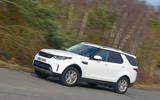What is it?
The Land Rover Discovery Si4, a four-cylinder petrol variant of the seven-seat luxury SUV, has been added to the range at a useful time to capitalise on the continuing slump in popularity of diesel engines.
The question is: can this turbocharged 2.0-litre inline four with 296bhp and 295lb ft really be a match for the kind of oil-burning unit that is traditionally found under the bonnet of practical-but-posh workhorses such as the Solihull-built Discovery?
The engine, part of Jaguar Land Rover’s Ingenium ‘AJ200’ family constructed at the engine manufacturing centre in Wolverhampton, has previously been added to the line-ups of the Land Rover Discovery Sport, Range Rover Velar and Evoque.

On the Discovery Si4, it is mated to the eight-speed ZF automatic transmission and four-wheel drive system that are ubiquitous across the fifth-generation Discovery’s range, which you can read more about in our full road test here.
Our test car came in SE trim, one up from the entry-level S specification, but it was still as well appointed as you’d hope a £50,000 SUV might be. Kit highlights include a 10.0in touchscreen infotainment system, air suspension, heated front seats, LED headlights, a 250W, 10-speaker sound system and leather front seats.
Options on our test car were limited to privacy glass (£400), a rear-view camera (£375) and 360deg parking assist (£280). The latter two proved useful for backing the Discovery into dauntingly tight multi-storey parking bays.























Join the debate
Add your comment
This petrol engine
produces 222g/km CO2 in a Discovery, but only 64g/km when mated to a hybrid system in the RangeRover P400, so now tell me its not a tax fiddle, and if its such an amazing hybrid system, why havent they fitted it in the Discovery?
Citytiger wrote:
I guess the hybrid powertrain is fitted only when and when it needs to be. When your model range is made up of heavy, high Co2 producing vehicles, one or two models producing very low figures help pull down your overall figure, why do anymore than you need to.
Number plate
The oddest design feature is
The oddest design feature is the body-coloured aggressively sloping thick C-pillar (all the other pillars are black and 'invisible'). It appears to grow upwards from the body to support the roof, and yet it is stopped by the black roof rail as a result of which the roof reads as a separate element.
How does Mr McGovern explain this?